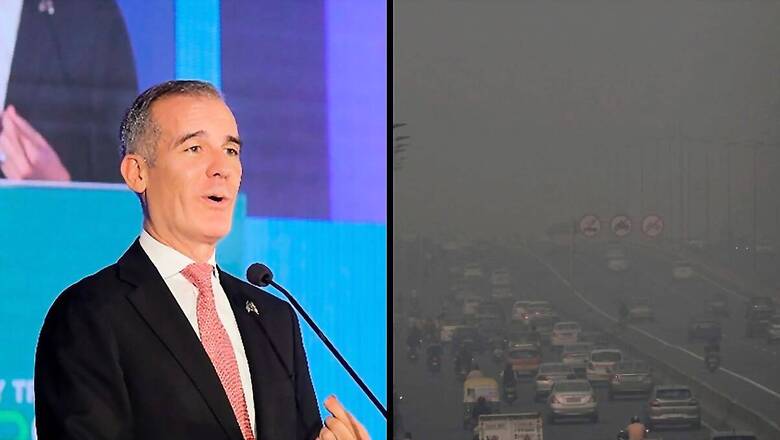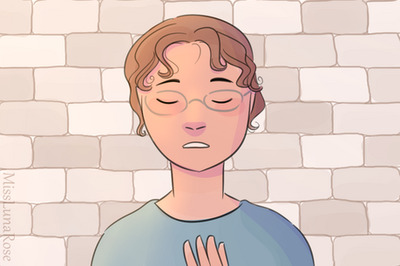
views
Delhi’s air quality index (AQI) breached the 400 mark to enter the severe category on Thursday. However, it’s all business as usual for Delhiites who are familiar with the scenes of smoky haze that obscure the skyline and hide the sun today. But guess who’s not?
Eric Garcetti, who took over as US Ambassador to India in May this year, expressed concern over the rising air pollution levels. He compared Delhi’s air pollution to Los Angeles in the 1970s and 1980s.
Garcetti, who earlier served as Mayor of Los Angeles, recalled his childhood days in Los Angeles where, he said, the air was the most polluted air anywhere in America at that time.
The US envoy said his daughter was given by her teacher in the city today about air pollution.
“On a day like this in Delhi, it brings back memories of growing up in Los Angeles where the air was the most polluted air anywhere in America. Where like today, we were given warnings by our teachers that you cannot go outside to play, just as my daughter was given by her teacher today as I dropped her off to school,” the US envoy said.
#WATCH | On air pollution in Delhi, US Ambassador to India, Eric Garcetti says, “On a day like this in Delhi, it brings back memories of growing up in Los Angeles where the air was the most polluted air anywhere in America. Where like today, we were given warnings by our teachers… pic.twitter.com/9ijgH8we0h— ANI (@ANI) November 2, 2023
Apocalyptic Haze Engulfs Delhi-NCR: AQI Touches 999 in Anand Vihar; Noida Breaches 450-Mark
Smoky Haze Thickened, Visibility Dropped
The smoky haze shrouding Delhi thickened on Thursday due to a surge in farm fires and unfavourable weather conditions, prompting doctors to issue warnings about breathing issues being aggravated.
An official from the India Meteorological Department reported that visibility was reduced to just 500 metres at the Safdarjung Observatory around 7 am, gradually improving to 800 metres as temperatures increased during the day.
Cold temperatures create stable atmospheric conditions, known as temperature inversions, where a layer of warm air traps cooler air near the ground, allowing the accumulation of pollutants.
At 3 pm, the city’s AQI reached 378. The 24-hour average AQI was 364 on Wednesday, 359 on Tuesday, 347 on Monday, 325 on Sunday, 304 on Saturday, and 261 on Friday. Several areas within the city, including Punjabi Bagh (439), Dwarka Sector-8 (420), Jahangirpuri (403), Rohini (422), Narela (422), Wazirpur (406), Bawana (432), Mundka (439), Anand Vihar (452) and New Moti Bagh (406), recorded ‘severe’ air quality.
An AQI between zero and 50 is considered ‘good’, 51 and 100 ‘satisfactory’, 101 and 200 ‘moderate’, 201 and 300 ‘poor’, 301 and 400 ‘very poor’, and 401 and 500 ‘severe’.
Health Professionals Express Concerns
Health professionals have expressed concerns that air pollution is increasing asthma and lung problems in children and the elderly. “We are recording a surge in the number of irritative bronchitis infections. It is recommended that people suffering from respiratory issues such as chronic bronchitis and asthma take their medicines regularly and do not go out in the open unless absolutely necessary,” said Jugal Kishore, the head of the medicine department at Safdarjung Hospital.
Considering the spike in indoor pollution in Delhi, he advised people to use air purifiers in their homes. One of the major reasons behind the accumulation of pollutants in recent days is the lack of rainfall during this post-monsoon season so far.
According to government data, Delhi’s air quality in October 2023 was the worst since 2020, with meteorologists attributing it to the absence of rainfall. The capital recorded an AQI of 210 in October, compared to 210 in October last year and 173 in October 2021, according to the Central Pollution Control Board (CPCB). In contrast to October 2022 (129 mm) and October 2021 (123 mm), Delhi experienced only one rainy day (5.4 mm of precipitation) in October 2023.
Unfavourable meteorological conditions, combined with emissions from firecrackers, paddy straw burning, and local pollution sources, contribute to hazardous air quality levels in Delhi-NCR during winter. According to an analysis conducted by the Delhi Pollution Control Committee (DPCC), the capital experiences peak pollution from November 1 to November 15 when the number of stubble burning incidents in Punjab and Haryana increase.
The Commission for Air Quality Management (CAQM), a statutory body responsible for formulating strategies to reduce pollution in Delhi-NCR, reported that the number of stubble burning incidents in Punjab and Haryana since September 15 has reduced by around 56 per cent and 40 per cent, respectively, compared to the corresponding period last year. The Punjab government aims to reduce farm fires by 50 per cent in this winter season and eliminate stubble burning in six districts.
(With PTI inputs)




















Comments
0 comment